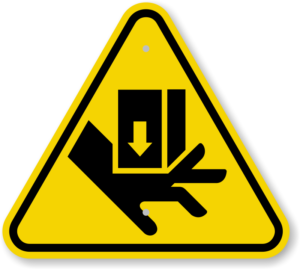
Automatic vehicular gate operating systems provide convenience and security to the end user. In some applications, gate operators must use high levels of force to move gates. If a system is not properly specified, installed, used, and maintained, serious injuries or death can result to someone in the vicinity of a moving gate. Some situations that can lead to a possibility of serious injuries or death include:

These situations may lead to persons coming in contact with the gate and “pinching” a portion of their body, or even worse, becoming “entrapped” by the gate.
A total system design is the most effective approach to preventing injuries related to automatic vehicular gate operating systems. This design must consider gate system specific application, user population, intended use, and environmental effects. Consideration of the application must include an evaluation of all potential hazards associated with a moving gate in order to incorporate appropriate safety features into every individual gate system. Specific features include such items as an inherent reversing device in the gate operator, edge sensors, photoelectric eyes, enclosed track, vertical guard posts, screen mesh, appropriate clearance of system controls from a moving gate, guarding for exposed rollers, and instructional and precautionary signage.
Gate operators should comply with the most current version of the Underwriters Laboratories standard UL 325, Standard for Door, Drapery, Gate, Louver, and Window Operators and Systems. Look for the “mark” of a labeling and listing agency (such as UL, ETL, CSA, etc.) indicating that the operator is in compliance with UL 325 requirements. Model codes, such as the International Building Code, International Residential Code and International Fire Code, require listed operators that bear a label from a listing agency.
With respect to gates, the codes also require compliance to ASTM F2200, Standard Specification for Automated Vehicular Gate Construction. Vehicular gates intended for automation should be designed, constructed, and installed in compliance with the ASTM F2200 standard.
Specifiers, designers, dealers, installers, trained gate system technicians, and end users each have specific roles in providing for safe operation of automatic vehicular gate operating systems:
Specifiers and designers should design an automatic vehicular gate system to:
Installers, during the course of the installation proceedings for each job, should:
End users should be made aware that they must:
The two most common types of gates are horizontal slide gates and swing gates. Identification of some potential hazards, and recommended solutions, are given below for these types of gates:
For all gate types, be sure that warning signs are prominently displayed on both sides of the gate and any other place where a potential hazard exists.

Nevada State Contractors License #74995

Call Gate Access Services today.
Nobody likes hearing “The gates are broken again”. We can keep your system running, make your life easier, eliminate frustration and establish a great communication system that keeps you informed.
702-903-1858
Monday – Thursday
Friday
Closed Daily For Lunch
Emergency Services
8 am – 4:30 pm
8 am – 3 pm
12 pm – 1 pm
After Hours, Weekend, and Holidays
Monday – Thursday
8 am – 4:30 pm
Friday
8 am – 3 pm
Closed Daily For Lunch
12 pm – 1 pm
Emergency Services
After Hours, Weekends, and Holidays